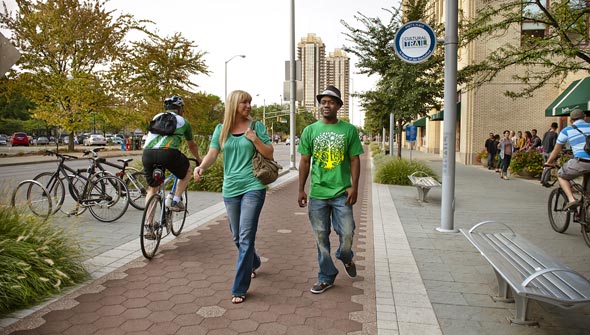Indianapolis Cultural Trail
300 S. Meridian St.

Downtown Indy’s new recreation path isn’t just a trail, it is a true trailblazer. Indianapolis Cultural Trail: A Legacy of Gene & Marilyn Glick is big, bold, and beautiful, and it has caught the attention of urban planners around the country. The Project for Public Spaces, based in New York City, has said, “There's really nothing like this in the world. This is an astonishing and amazing vision that will transform Indianapolis."
The 8-mile trail encircles downtown Indianapolis, passing through the city’s visitor and business district, its arts and cultural hubs, and its neighborhoods. Where most saw ordinary sidewalks, a group of progressive community leaders in Indianapolis envisioned alluring, wide paths made for pedestrians and cyclists, lined with distinctive lighting and landscaping, and enlivened by original large-scale art. No other city could have considered reclaiming sidewalks and one lane of traffic to create a greenway of such scale, while also preserving generously wide roads. Downtown Indy’s spacious street layout made it possible here.
While most urban greenways lead traffic away from the city to riverfronts or other outskirts, the Indianapolis Cultural Trail serves as a gateway into the heart of the city. The name—the Cultural Trail—refers to the five official cultural districts along the route. Once disparate districts without a relationship to one another, these destinations are now linked, and the individual, culture-rich areas are part of a greater whole, enhancing their appeal and maximizing their potential. The trail passes within one block of every major arts, culture, heritage, and sports venue in the city.
The trail also serves as the link completing the city’s greenway system. Before the Cultural Trail, two greenways served downtown, and their trailheads were far apart. The Cultural Trail connects to both of them, closing the loop for a continuous route dedicated to nonmotorized traffic. In this way, the Cultural Trail is truly indigenous, responding to Indy’s urban environment and solving problems that it faced.
Construction progressed steadily since the 2007 groundbreaking, and new corridors opened each year. With a target completion date of 2011 for hardscape (and spring 2012 for the last of the landscaping), the Central Indiana Community Foundation, which oversees the project, stayed on course even through a recession and raised more than $60 million. Approximately two-thirds of the funding was private, and one-third came from a federal transportation grant. More than 1 million users are expected to use the completed trail.
The trail’s design is as innovative as the concept. Designed by Indianapolis’ Rundell Ernstberger Associates, it’s up to 25 feet wide in some places, and more than half is divided into separate sides for cyclists and foot traffic. Features include bright, contemporary signage; stormwater planters with open bottoms that allow rain to drain to the ground, reducing runoff and the burden on the city’s sewer system; pedestrian crossings with an audio component for the visually impaired; and plaza-like corners that extend into the street further than typical sidewalks, shortening the distance from one corner to the other. Also, the construction process incorporated about $20 million in city infrastructure improvements that might not have been done otherwise. As an urban-design asset, the trail beautifies many parts of downtown and improves the livability of some economically needy areas.
Trail users can discover around $2 million worth of original, commissioned artwork. The large-scale pieces include an LED image of a woman dancing — designed by internationally renowned artist Julian Opie — large gates with solar-powered ambient lighting, a scent vault, a sculpture garden honoring great visionaries throughout history, resin bus shelters displaying original poetry, and a light installation that simulates a swarm of fireflies along what used to be a dark stretch of road.
Even considering its ambitious design, The Indianapolis Cultural Trail has exceeded expectations. It’s not just a way to get from point A to point B. It is an experience itself, a discovery of art, place, and life. It connects its users with each other and with their city in a way that has not been done before in Indianapolis, or in the country, proving that a journey can also be a destination.
